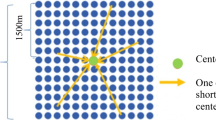Abstract
In the real world, there are many kinds of phenomena that are represented by points on a network, such as traffic accidents on a street network. To analyse these phenomena, the basic point pattern methods (i.e. the nearest neighbour distance method, the quadrat method, the K-function method and the clumping method) defined on a plane (referred to as the planar basic point pattern methods) are extended to the basic point pattern methods on a network (referred to as the network basic point pattern methods). However, like the planar basic point pattern methods, the network basic point pattern methods assume a uniform network and this assumption is hard to accept when analysing actual phenomena. To overcome this limitation, this paper formulates a transformation, called the uniform network transformation, that transforms a non-uniform network into a uniform network. This transformation provides a simple procedure for analysing point patterns on non-uniform networks: first, a given non-uniform network is transformed into a uniform network; second, the network basic point pattern methods (which assume a uniform network) are applied to this transformed uniform network. No modification to the network basic point pattern methods is necessary. The paper also shows an actual application of this transformation to traffic accidents in Chosei, Japan.







Similar content being viewed by others
References
Busacker RG, Saaty TL (1965) Finite graphs and networks. McGraw-Hill, New York
Clark PJ, Evans FC (1954) Distance to nearest neighbor as a measure of spatial relationships in population. Ecology 35:45–453
Clevenger AP, Chruszcz B, Gunson KE (2003) Spatial patterns and factors influencing small vertebrate fauna road-kill aggregations. Biol Conserv 109:15–26
Dacey MF (1968) Two-dimensional random point patterns A review and an interpretation. Pap Reg Sci Assoc 13:41–55
Getis A (1963) The determination of the location of retail activities with the use of a map transformation. Econ Geogr 39:14–22
Goto H, Yamada I, Okabe A, Yamazaki T, Kohsaka H, Kaneko T, Takami K (2000) Spatio-temporal analysis of sport clubhouse members (in Japanese). Pap Pro Geogr Inf Syst 9:219–223
Miller HJ (1994) Market area delimitation within networks using geographic information systems. Geogr Syst 1(2):157–173
Miller HJ (1999) Measuring space-time accessibility benefits within transportation networks: basic theory and computational methods. Geogr Anal 31:187–212
Morita M, Okunuki K, Okabe A (2001) A market area analysis on a network using GIS: a case study of retail stores in Nisshin City (in Japanese). Pap Proc Geogr Inf Syst Assoc 10:45–50
Okabe A (2002) Uniform network transformation for spatial analysis on a heterogeneous network. Discussion Paper 51, Center for Spatial Information Science, University of Tokyo
Okabe A, Shiode S (2003) Cell count method on a network with SANET. Discussion Paper 59, Center for Spatial Information Science, University of Tokyo
Okabe A, Kitamura M (1996) A computational method for market area analysis on a network. Geogr Anal 28(4):330–349
Okabe A, Okunuki K (2001) A computational method for estimating the demand of retail stores on a street network and its implementation in GIS. Trans GIS 5(3):209–220
Okabe A, Yamada I (2001) The K-function method on a network and its computational implementation. Geogr Anal 33(3):271–290
Okabe A, Yomono H, Kitamura M(1995) Statistical analysis of the distribution of points on a network. Geogr Anal 27(2):152–175
Okabe A, Boots B, Sugihara K, Chiu SN (2000) Spatial tessellations: Concepts and applications of Voronoi diagrams, 2nd edn. Wiley, Chichester
Okabe A, Okunuki K, Shiode S (2005) SANET: A toolbox for spatial analysis on a network. Geographical Analysis (in press)
Okunuki K, Okabe A (2002) Solving the Huff-based competitive location model on a network with link-based demand. Ann Oper Res 111:239–252
Ripley BD (1981) Spatial statistics. Wiley, New York
Roach SA (1968) The theory of random clumping. Methuen, London
Rossmo DK (2000) Geographical profiling. CRC Press, Boca Raton
Spooner P, Lunt I, Okabe A, Shiode S (2004) Spatial analysis of point patterns on road networks using the network K-function. Landscape Ecology 19(5):491–499
Tobler W (2001) The world is shriveling as it shrinks, Lecture at Texas A & M, October (downloadable from http://www.geog.ucsb.edu/∼tobler/)
Tobler W (2004) Thirty-five years of computer cartograms. Ann Assoc Am Geogr 94:58–73
Wieczorek GF (1984) Preparing a detailed landslides-inventory map for hazard evaluation and reduction. Bull Assoc Eng Geologists 21:337–342
Yamada I, Thill J-C (2004) Comparison of planar and network K-functions in traffic accidents analysis. J Transp Geogr 12:149–158
Zhang J (1997) Designing a cost-effective and reliable pipeline leak-detection system. Pipe Pipelines Int, Jan–Feb:20–25
Acknowledgements
An earlier version of this paper was presented at a session in GIScience2000 held at Savannah, GA, USA, 2000, where we had valuable comments from the floor. We thank three anonymous referees, and Waldo Tobler, Alan Murry, and Ikuho Yamada for their valuable comments on earlier versions of this paper. We also thank the Chiba Prefecture Police for offering traffic accident data. This study is partly supported by Grant-in-aid No. 10202201, Japanese Ministry of Education and Science.
Author information
Authors and Affiliations
Corresponding author
Rights and permissions
About this article
Cite this article
Okabe, A., Satoh, T. Uniform network transformation for points pattern analysis on a non-uniform network. J Geograph Syst 8, 25–37 (2006). https://doi.org/10.1007/s10109-005-0009-2
Published:
Issue Date:
DOI: https://doi.org/10.1007/s10109-005-0009-2
Keywords
- Uniform network transformation
- Network spatial analysis
- Nearest neighbour distance method
- Quadrat method
- K-function method




